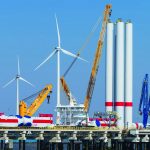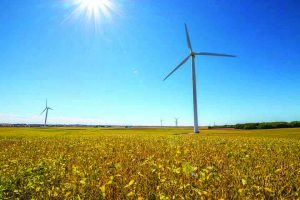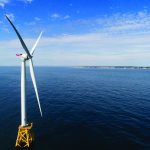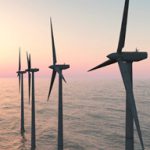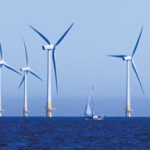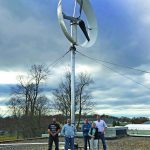American wind power supported a record 88,000 jobs at the start of 2016 — an increase of 20 percent in one year according to the U.S. Wind Industry Annual Market Report, Year Ending 2015, released by the American Wind Energy Association (AWEA). Strong job growth coincided with wind ranking No. 1 as America’s leading source of new generating capacity last year.
“Wind power benefits more American families than ever before,” said Tom Kiernan, CEO of AWEA. “We’re helping young people in rural America find jobs close to home, while others are getting a chance to rebuild their careers by landing a job in the booming clean energy sector. With long-term stable policy in place and a broader range of customers now buying low-cost wind-generated electricity, our workforce can grow to 380,000 well-paying jobs by 2030.”
Congress passed a long-term extension of the wind energy Production Tax Credit and alternative investment tax credit with bipartisan support in late 2015. With the extension in place and the recent industry growth, wind energy is on track to meet the United States Department of Energy’s (DOE) Wind Vision scenario of supplying 20 percent of U.S. electricity by 2030.
“Made-in-the-U.S.A. wind power will help keep our economy competitive and our air clean for generations,” Kiernan said. “Our wind energy will never run out.”
Chris Brown, president of Vestas Americas and incoming AWEA board chair, recently hosted an event at Vestas Americas Wind Systems’ Brighton, Colorado, manufacturing plant that assembles turbine nacelles, which house the gearbox and electrical generator at the top of a wind turbine. Vestas employs nearly 3,700 Colorado workers, and the state is home to two of the nation’s top wind technician training programs.
“Innovative turbine technology has cut the cost of wind energy by two-thirds in just six years,” Brown said. “Our job growth and cost-cutting is showing state policymakers and utilities how zero-emissions wind turbines are the economical and environmental solution for cutting carbon pollution cost-effectively.”
State-by-state job growth and economic benefit rankings
The job growth in 2015 is primarily attributed to more wind project development and construction, requiring more than 38,000 employees. The industry also experienced a stabilization of its manufacturing sector, which now supports over 21,000 well-paying jobs across 43 states, an increase of more than 10 percent in a year. Additionally, more than 8,800 jobs are currently held by wind turbine technicians — the fastest growing profession in the U.S. according to the Bureau of Labor Statistics.
Texas leads the nation with over 24,000 wind energy employees. Wind project construction propelled Oklahoma to second place with more than 7,000 jobs. Rounding out the top five are Iowa and Colorado with over 6,000 jobs, and, after moving up 11 spots, Kansas ranks fifth with over 5,000 wind workers. Maine gained the most in the state wind employment rankings, rising 16 spots.
Jobs at wind farms, wind-related manufacturing facilities, or both, are now located in 70 percent of U.S. congressional districts.
Across the U.S., wind has attracted $128 billion in new wind project investment over the last 10 years. Texas ranks number one with the most capital investment at more than $32.7 billion, followed by California over $11.9 billion, Iowa at $11.8 billion, Oklahoma at $9.6 billion, and Illinois at $7.7 billion.
Also, 70 percent of wind farms are located in low-income counties, supplying them with an economic boost. Wind developers pay a growing total of $222 million a year in land lease payments to U.S. farmers, ranchers, and other rural landowners.
Rapid growth fuels hiring boom
The wind rush grew stronger in 2015 as the American industry installed 8,598 MW of electric generating capacity across 20 states. That’s the third most in a year and a 77-percent increase since 2014. Wind’s first-place finish in new power plant installations represented 41 percent of all new capacity that came online in 2015, ahead of solar at 28.5 percent and natural gas at 28.1 percent.
An additional 9,400 MW of wind capacity was under construction as of the start of 2016, with another 4,900 MW in advanced stages of development.
Two Colorado wind projects alone are expected to save consumers $231 million over 20 years and have already saved the state more than $20 million in fuel costs. Additional data shows that consumers in the 10 states with the most renewable energy pay less on their electricity bills than the 10 states with the least renewable energy. Growing wind energy to 35 percent of the U.S. electricity supply by 2050 will eventually save American consumers $14 billion per year with cumulative savings on their electric bills of $149 billion.
Upgrading the nation’s grid and adding new transmission is expected to deliver more clean energy and savings to densely populated U.S. cities that need it most. The Upper Midwest grid operator, for example, found $50 billion in net benefits from such projects, equaling $1,000 per customer.
Transmission taps more affordable energy sources at all hours for major cities and big brands like Google and Microsoft. Major brands and other emerging non-utility customers signed 52 percent, or 2,074 MW, of the wind power capacity contracted through power purchase agreements (PPA) in 2015. Low-cost wind energy increasingly appeals to organizations with goals to lower emissions and to protect their bottom line.
States expand wind energy use, which opens greater access to clean air
Wind energy supplied more than 31 percent of Iowa’s in-state electricity production in 2015, making it the first state in the U.S. to surpass the 30-percent mark. Altogether, 12 states generated at least 10 percent of their electricity with wind energy.
Xcel Energy, the main utility in Colorado, has satisfied over 66 percent of its demand for electricity with wind at times. In the last several weeks, wind provided more than 48 percent of the electricity on the main Texas grid and on the Southwest Power Pool.
 “We have cultivated wind as our most cost-effective renewable energy option because we recognize that this source of energy is not only a benefit to the environment, but also a major economic driver for the state,” said David Eves, president of the Public Service Company of Colorado, an Xcel Energy company. “Our plan is to expand our wind offerings to provide hundreds of new jobs for Coloradans, make a billion dollars in new investments, keep energy costs low for our customers, and improve the environment.”
“We have cultivated wind as our most cost-effective renewable energy option because we recognize that this source of energy is not only a benefit to the environment, but also a major economic driver for the state,” said David Eves, president of the Public Service Company of Colorado, an Xcel Energy company. “Our plan is to expand our wind offerings to provide hundreds of new jobs for Coloradans, make a billion dollars in new investments, keep energy costs low for our customers, and improve the environment.”
As a result, Americans can breathe easier due to pollution-free, renewable wind energy displacing harmful emissions from other energy sources.
Each new wind turbine typically avoids over 4,200 metric tons of carbon dioxide (CO2) per year, equal to approximately 900 cars’ worth. U.S. wind energy avoided 132 million metric tons in total CO2 emissions last year, equal to eliminating all electric power sector emissions from Kansas, Nebraska, Oklahoma, and Colorado.
Wind energy also greatly reduces a variety of health-harming air pollutants, including smog-causing sulfur dioxide (SO2) and nitrogen oxides (NOx), which helps reduce asthma attacks and other respiratory issues. That displaced an estimated 176,000 metric tons of SO2 and 106,000 metric tons of NOx in 2015, representing $7.3 billion in avoided health costs last year alone.
— Source: AWEA
For more information, go to www.awea.org.


















